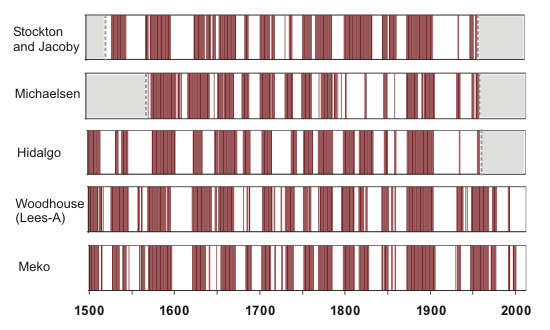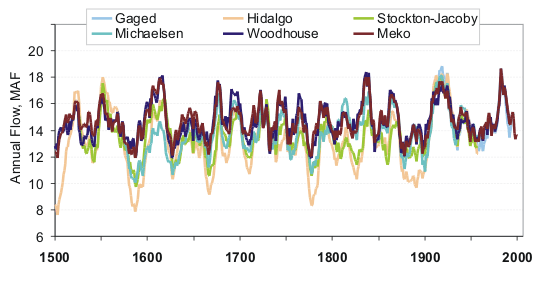Comparison of the Lees Ferry reconstructions
The previous pages have described several different tree-ring reconstructions of annual streamflow at Lees Ferry. Although the reconstructions share similar patterns of wet and dry periods, they also differ in a number of respects. This page will explore the source of both the similarities and the differences.
Common Ground
As shown in the figure below, the various reconstructions generally agree in how they represent wet and dry periods on the Colorado River. This is because regional climate very strongly influences tree growth across the upper Colorado River basin, and streamflow as well. Although the reconstructions do vary in the data and methods used to generate them, as discussed below, the strong common climate signal recorded in the trees can be clearly seen.

Differences
While the reconstructions look broadly similar, especially in the timing of wet and dry periods, some features of the reconstructions--like the long-term means and the specific magnitudes of wet and dry periods--can be quite different, as seen in the figure and table below.

Note that the reconstructions are very similar to each other from about 1900-2000, since they are calibrated to very similar gage records during this period. Before 1900 the reconstructions diverge somewhat from each other in how they represent wet and dry periods. The Hidalgo et al. reconstruction shows more severe droughts than the other reconstructions, followed by Stockton and Jacoby, then Woodhouse et al. and Meko et al.
Why are the reconstructions different? Because the specific input data and the methods used to generate the reconstruction have varied among the reconstructions. These differences include:
- The gaged or natural flow record used to calibrate the model
- The length of the calibration period
- The set of tree-ring data used to generate the reconstruction (locations, species, etc.)
- The statistical treatment of the tree-ring chronologies
- The regression approach used for the modeling
The first of these, differences among the gaged records, probably does not matter too much since the gaged record has had only minor refinements over the past 40 years. The other four probably all can have significant effects, but it is not quite clear which is the most important in creating the differences among the final reconstructions. Research is underway to further investigate these differences.
| Reconstruction |
Calibration period
|
Reconstruction period
|
Long-term (1568-1961) mean flow, MAF |
Mean flow, late 1500s drought (1579-1600), MAF
|
| Stockton and Jacoby (1976) |
1914-1961
|
1520-1961
|
13.4
|
11.1
|
| Michaelsen et al. (1990) |
1906-1962
|
1568-1962
|
13.8
|
10.6
|
| Hidalgo et al. (2000) |
1914-1962
|
1493-1962
|
13.0
|
9.1
|
| Woodhouse et al. (2006) (Lees-A) |
1906-1995
|
1490-1997
|
14.7
|
12.9
|
| Meko et al. (2007) |
1906-2004
|
762-2005
|
14.7
|
12.8
|
Table: selected attributes of the five Lees Ferry streamflow reconstructions.
Uncertainties
Since the trees do not capture 100% of the variability seen in the gaged (natural flow) record, we know there is uncertainty in the estimates of past streamflow. We can estimate this uncertainty using the average error in the reconstruction model (reconstructed flow minus gaged flow) during the calibration period, and assume that this uncertainty applies to the portion of the reconstruction prior to the calibration period. We can also use the error to generate "confidence intervals" or "error bars" around the reconstruction. Doing this reinforces the idea that the reconstruction is an estimate with uncertainty around it, and the reconstructed streamflow for each year really represents a range of probable values, described by the confidence intervals.
Other forms of uncertainty come from the host of choices made in the reconstruction process, as described in the previous section. Since we see that changes in the modeling input and methods leads to different results, there is uncertainty that follows the decisions made during the reconstruction process. These sources of uncertainty have not yet been quantified, but an ensemble approach to reconstructions (intentionally using different data and methods in multiple models to see the effects on the results) may provide some guidance.
Which reconstruction is "right"?
No reconstruction provides the one "right" answer. They are all plausible estimates of past streamflow, with uncertainties attached to the estimates. But we can say that some reconstructions are more probably more reliable than others, that is, likely to be closer to the actual streamflow. In general, the most recent reconstructions, having a longer calibration period (90-100 years) than the previous reconstructions (50 years) are likely to be more reliable. The longer calibration period imposes a stronger "test" of the tree-ring data that is selected in the modeling process: if the tree-ring data can accurately estimate gaged streamflow for 100 years (versus only 50 years), it is more likely to be able to estimate streamflow for prior centuries.



